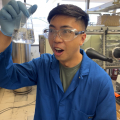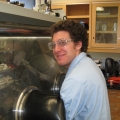Uranium-Ligand Multiple Bonds
Small molecule activation is the cornerstone or modern organometallic chemistry. It is a key to many important transformations, including olefin polymerization, C-H bond activation, ammonia synthesis, and water oxidation. Unlike the transition metals, where small molecule activation has been studied for 50+ years, uranium small molecule activation is a nascent field with many fundamental discoveries yet to be made. This represents a lost opportunity since uranium exhibits properties not found in any other element and may display reactivity beyond that of the transition metals. In particular, its large ionic radius and the presence of both d and f orbitals suggest the possibility of designing unprecedented catalytic transformations. Our research program intends to fully realize the promise of uranium by closing the gaps in our understanding of this element. Recently we developed a new route to the formation of terminal chalcogenides via cleavage of a trityl protecting group. We are now investigating the coordination chemistry and reactivity of these complexes to better understand the nature of U=E bonds (E = O, S, Se, Te).











